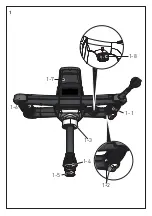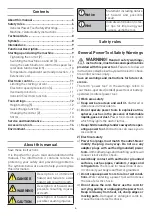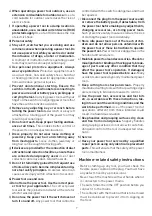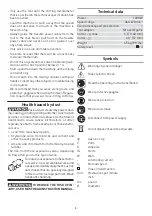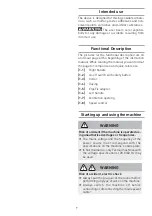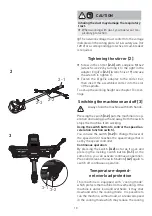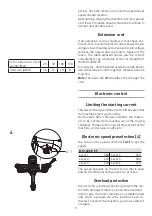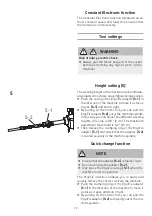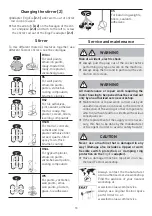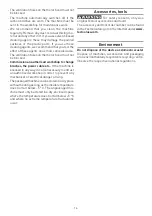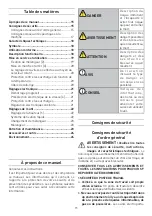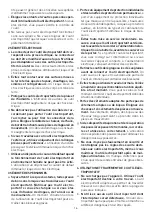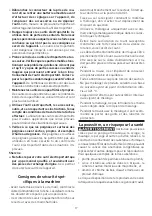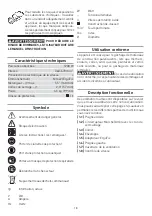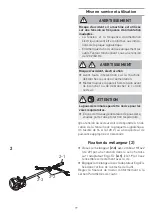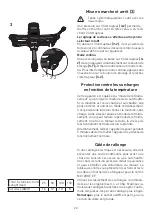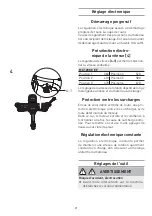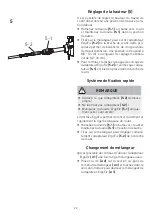
7
e)
When operating a power tool outdoors, use an
extension cord suitable for outdoor use.
Use of a
cord suitable for outdoor use reduces the risk of
electric shock.
f)
If operating a power tool in a damp location is
unavoidable, use a residual current device (RCD)
protected supply.
Use of an RCD reduces the risk
of electric shock.
3) Personal safety
a)
Stay alert, watch what you are doing and use
common sense when operating a power tool. Do
not use a power tool while you are tired or under
the infl uence of drugs, alcohol or medication.
A moment of inattention while operating power
tools may result in serious personal injury.
b)
Use personal protective equipment. Always
wear eye protection.
Protective equipment such
as a dust mask, non-skid safety shoes, hard hat
or hearing protection used for appropriate condi-
tions will reduce personal injuries.
c)
Prevent unintentional starting. Ensure the
switch is in the off-position before connecting to
power source and/or battery pack, picking up or
carrying the tool.
Carrying power tools with your
fi nger on the switch or energising power tools that
have the switch on invites accidents.
d)
Remove any adjusting key or wrench before
turning the power tool on.
A wrench or a key left
attached to a rotating part of the power tool may
result in personal injury.
e)
Do not overreach. Keep proper footing and bal-
ance at all times.
This enables better control of
the power tool in unexpected situations..
f)
Dress properly. Do not wear loose clothing or
jewellery. Keep your hair and clothing away
from moving parts.
Loose clothes, jewellery or
long hair can be caught in moving parts.
g)
If devices are provided for the connection of dust
extraction and collection facilities, ensure these
are connected and properly used.
Use of dust
collection can reduce dust-related hazards.
h)
Do not let familiarity gained from frequent use
of tools allow you to become complacent and ig-
nore tool safety principles.
A careless action can
cause severe injury within a fraction of a second.
4) Power tool use and care
a)
Do not force the power tool. Use the correct pow-
er tool for your application.
The correct power
tool will do the job better and safer at the rate for
which it was designed.
b)
Do not use the power tool if the switch does not
turn it on and off.
Any power tool that cannot be
controlled with the switch is dangerous and must
be repaired.
c)
Disconnect the plug from the power source and/
or remove the battery pack, if detachable, from
the power tool before making any adjustments,
changing accessories, or storing power tools.
Such preventive safety measures reduce the risk
of starting the power tool accidentally.
d)
Store idle power tools out of the reach of chil-
dren and do not allow persons unfamiliar with
the power tool or these instructions to operate
the power tool.
Power tools are dangerous in the
hands of untrained users.
e)
Maintain power tools and accessories. Check for
misalignment or binding of moving parts, break-
age of parts and any other condition that may
affect the power tool’s operation. If damaged,
have the power tool repaired before use.
Many
accidents are caused by poorly maintained power
tools.
f)
Keep cutting tools sharp and clean.
Properly
maintained cutting tools with sharp cutting edges
are less likely to bind and are easier to control.
g)
Use the power tool, accessories and tool bits
etc. in accordance with these instructions, tak-
ing into account the working conditions and the
work to be performed.
Use of the power tool for
operations different from those intended could
result in a hazardous situation.
h)
Keep handles and grasping surfaces dry, clean
and free from oil and grease.
Slippery handles
and grasping surfaces do not allow for safe han-
dling and control of the tool in unexpected situa-
tions.
5) Service
a)
Have your power tool serviced by a qualifi ed
repair person using only identical replacement
parts.
This will ensure that the safety of the power
tool is maintained
.
Machine-related safety instructions
- Before starting up any tool, you must check the
fl exible power cable and the plug. You must have
any defects fi xed by a professional.
- Never touch the machine with wet hands when it
is connected to the power mains.
- The switch must be in the OFF position before you
connect it to the mains.
- The container with the material that is to be mixed
must be stabilised to prevent it from slipping on
the fl oor.
Summary of Contents for MX 1200 E EF
Page 2: ......
Page 3: ......
Page 4: ...1 1 1 1 2 1 3 1 4 1 5 1 6 1 7 1 8 ...
Page 5: ......
Page 35: ...35 NOTES NOTACIONS NOTAS ...
Page 36: ...36 NOTES NOTACIONS NOTAS ...




